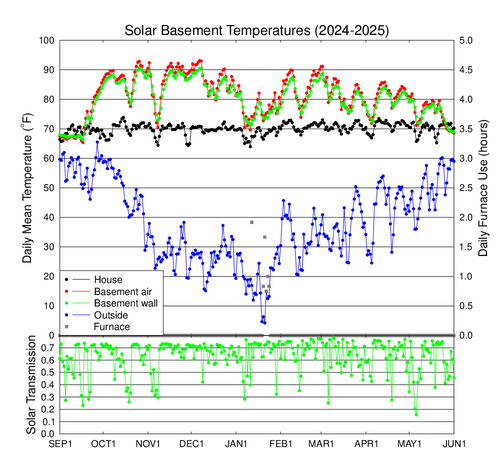Passive Solar Basement Efficiency

Click on the graph for a larger version.
The graph above shows the observed daily average temperatures for the 2024-2025 heating season. The grey squares (along with the y axis on the right edge of the plot) show how many hours per day the backup propane furnace ran. The lower graph shows the ratio of daily average surface solar flux to the top of atmosphere solar flux. The surface solar flux on a horizontal plane is measured by the weather station, and the top of atmosphere solar flux is calculated for the date and location. Sunny days have a solar transmission above 0.7, and cloudy days have lower values.
We used our usual procedure this heating season by running the furnace when really needed. The daily average house temperature fell below 65oF on 5 days, and the coldest average house temperature was 64.0o in early January. The beginning and end of our heating season (when the reflectors were not blocking the basement windows) was September 18 and May 22, respectively.
The large dip in basement temperature in early November was due to
six cloudy days in a row (four very cloudy) associated with a heavy
snowfall. The dips in house temperature at the end of November and
mid-May were when we were away traveling.

Click on the graph for a larger version.
The above graph shows the total heating degree days (HDD) accumulated
through the season and total BTUs provided by the propane furnace in our
house. These HDD are defined relative to the standard 65oF.
The furnace BTUs are calculated using the 70,000 BTU/hour furnace rating
and the time the furnace is on as measured by the computer. This season the furnace was used for exactly seven hours. The ratio of
BTUs to heating degree days divided by the floor area of the house (1508
square feet) is plotted in the lower panel. This ratio is called the
heating intensity index, and is a measure of how efficient the house is.